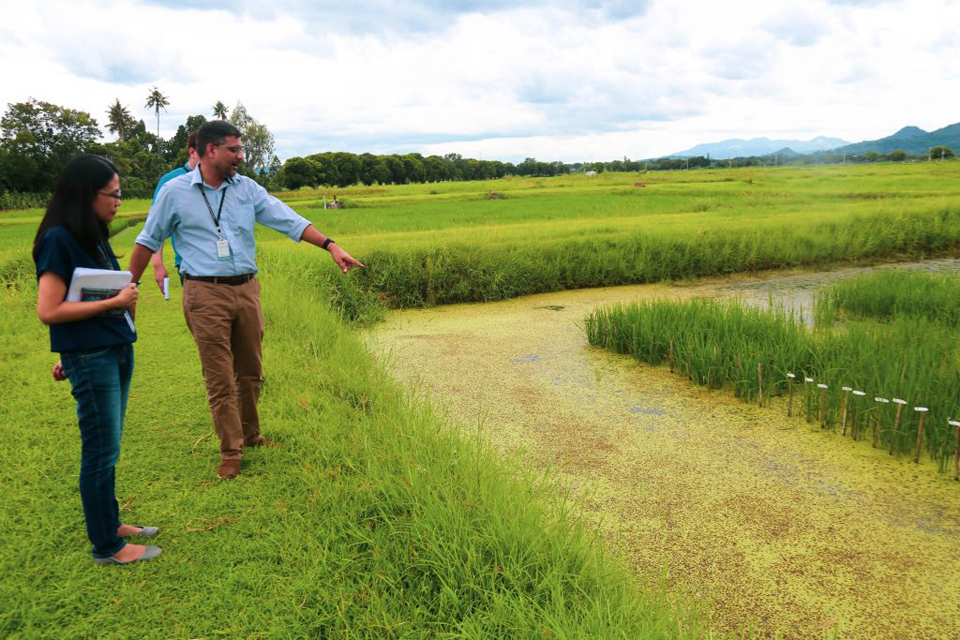
The Philippines is one of the most disaster-hit countries in the world. Every year, around 20 tropical cyclones hit the country; ten of which are typhoons with five being destructive.
According to the Department of Agriculture-Field Programs Operational Planning Division, for the past five years, the average loss for rice is at 519,581 hectares or 597,484 metric tons production due to typhoons.
With these alarming numbers and the vulnerable position of the country in the western Pacific Ocean, which is the brewing ground for typhoon formation and also sits in the “Pacific Ring of Fire,” makes it vulnerable to frequent earthquakes and volcanic eruptions. Its geographical location and physical environment also contributes to its high-susceptibility to tsunami, sea level rise, storm surges, landslides, flood/flashflood/flooding, and drought not to mention the effects of climate change.
In the Philippines, rice is the main food staple and it is even also considered as a political commodity. Our rice farmers are working fervently to meet the rice requirement, and ultimately achieve rice self-sufficiency. However, while the weather is farmer’s best friend, it is also their worst enemy during extreme weather conditions like excessive flooding.
Rice is a semi-aquatic crop, however, the ability to survive complete or partial flooding is limited for most of the rice varieties. On the other hand, there are traditional varieties that have adopted well in flooded environments. These varieties are low yielding and have poor grain quality in some cases. The International Rice Research Institute (IRRI) has been studying the genetics underlying the trait of these traditional rice varieties that can tolerate higher level and longer duration of flooding.
Flooding explained
Dr. Shalabh Dixit, IRRI’s trait pipeline lead for marginal environments said IRRI’s work in developing flood-tolerant varieties address the three forms of flooding: stagnant flooding, complete submergence due to flash floods, and anaerobic germination.
The stagnant flooding is a condition where water stays more than a month and the lines remain partially submerged. The complete submergence usually happens at seeding-vegetative stage due to typhoons or heavy rains. The anaerobic germination happens in a direct seeding method of planting seed and the field gets flooded, resulting to the poor germination of the rice seed.
The development of IR 64 Sub 1 and other flood tolerant varieties
Realizing the need to develop flood tolerant rice varieties, IRRI picked not only a high yielding variety but also captured the ones that grow well in the country. After years of rigorous testing and research, the IR 64 was born. The IR 64 was a widely used variety in Asia. In 2008-2009, the sub 1 was introduced into the variety. Sub1 gene came from a traditional flood tolerant variety in India.
“This traditional variety exemplifies good submergence tolerance and can survive under water better than normal high yielding varieties. Genetic studies were conducted using this variety which led to the identification of the Sub 1 gene. The gene was then introgressed into different mega varieties including the IR 64, TDK 1 from Laos, Swarna from India, among others and several sub 1 varieties of these mega varieties was created,” Dixit explained.
The IR 64 Sub 1, also known as Submarino 1 (NSIC Rc194), works well under complete flooding/submergence but does not do well under stagnant flooding. For rice fields that experience stagnant flooding, farmers can use IR119, also known as RC 68 that works better under stagnant flooding.
All of these varieties are inbred which means that the seeds produced from these varieties can be re-used for planting but the purity of the seeds needs to be maintained to enjoy the advantages. These varieties are also non-GM (genetically modified) food as IRRI uses molecular techniques in developing them.
Dr. Dixit pointed out another advantage of varieties with anaerobic germination. Farmers growing these varieties under direct seeded conditions have higher surety of crop stand and can use water to control weeds, which is more cost-effective and lessens the use of chemicals and other herbicides. It also saves farmer from hand pulling of weeds as it is no longer needed. Thus, it aids in reducing the farmer’s farm inputs while increasing its yield.
Challenges ahead
Some may wonder why we are still incurring huge losses in rice during the rainy season despite of the availability of these flood tolerant varieties. Dr. Dixit explained one of the possible reasons why farmers are not yet fully embracing these varieties is because the advantages can only be realized when severe flooding occurs. “Farmers always opt for the higher yielding varieties as compared to flood tolerant varieties,” he added.
IRRI is continuously developing rice varieties that are not only flood tolerant but also has other desirable rice traits favorable for farmers while maintaining the same crop management practices and applying their known methods in growing traditional rice varieties.
Dr. Dixit shared the common problems in flood prone areas, are the infestation of different pests, diseases, weather extremes like drought and flooding, as well as concerns about the stability of income. “If farmers do not feel secure, they will not put enough farm input and instead put these into their savings; this results into lower yield due to insufficient farm inputs. If you can give them the sense of security, then they will apply sufficient farm input.” he added.
More robust varieties that can handle multiple stresses like drought, disease resistance, salinity, different types of flooding while maintaining or even producing higher yield can be expected in the future. Achieving a food secure future despite the challenges posed by climate change requires a collaborative work among research institutions, government, private, and public sector. ### (Carlos Cezar Baldosa, DA-AFID)













